Planting for pest and disease resistance
Choosing plants to ensure the long-term health of green spaces
Over the past 20 years, the global travel and shipping industries have seen a massive increase in size, due to reduced costs of travel, and a more globalised society. This comes with many benefits, such as being able to go on holiday further afield, or being able to import goods more cheaply and easily. In the UK horticulture industry, it has allowed greater availability of plants and trees, as well as access to a larger variety of different species, at a reduced cost of importation. With this, however, has come an increase in the spread of invasive pests and diseases. When a pest or disease arrives into an ecosystem to which it is non-native, it is more effective in attacking and destroying the local plant life, as there has been no evolution in the plants to resist these particular threats. This can therefore make the threat of diseases which are introduced via imported plants very serious. You can read more about the importance of biosecurity in our previous blog here.
A number of steps have been taken in the UK in order to help mitigate the spread of foreign threats to our ecosystems, including strict border checks, plant passports, which ensure regular checks have taken place on every plant, and the ‘Plant Healthy’ scheme, which recognises horticultural businesses who take biosecurity seriously, and have strict procedures in place to ensure the highest standards are maintained. Greenwood is proud to be Plant Healthy certified, having undergone inspection earlier this year. Despite this, there has been a significant rise in the number of outbreaks of pests and diseases in the UK over the last 20 years, with multiple threats causing widespread damage to native ecosystems. There are many organisations with a specific purpose to help identify and contain the spread of these invasive pests and diseases, such as DEFRA (Department for Environment, Food and Rural Affairs), APHA (Animal and Plant Health Agency), PHSI (Plant Health and Seeds Inspectorate), as well as The Forestry Commission. One of the best ways in which to prevent the spread, however, is by carefully selecting plants for projects, taking into account their ability to resist current biosecurity threats. In this article, we will identify the most abundant invasive threats to the UK ecosystems, as well as the common plants which are most vulnerable to each pest or disease, and suggest alternatives which are more resistant, and not only help to prevent the further spread of these threats, but to help ensure the long term survival of native ecosystems.
Box blight
Box blight is a disease which primarily affects the Buxus genus, most notably, the common hedging plant Buxus sempevirens. The first recorded case to be identified as box blight was in the mid-1990s in the UK, and since then, it has been recorded all over the planet, in areas as far afield as New Zealand. It is caused by two very closely related fungi, Calonectria pseudonaviculata and Calonectria henricotiae, which attack the leaves and stems of the plant, eventually causing browned leaves, and dieback of the plant. There isn’t currently a known cure for the disease; it can be controlled, but requires extensive care and maintenance to isolate it and prevent further spread. This can prove to be difficult when planting in homes or public spaces which do not have a regular, ongoing maintenance program. If the homeowner or landowner is not aware of the signs of the disease, it can very easily spread and cause widespread damage without intervention. As an evergreen, UK native hedge, Buxus has been an important staple plant choice in many gardens, being ideal for biodiversity and for dense hedges, shrubs, and topiary. With the problems caused by not only box blight, but the box tree caterpillars and box sucker pests, many garden designers have been forced to move away from the use of box, in order to ensure resilient, healthy green spaces, that do not require ongoing care and maintenance.
Fortunately, there are a number of alternative options with dense foliage which can be used to replace Buxus:

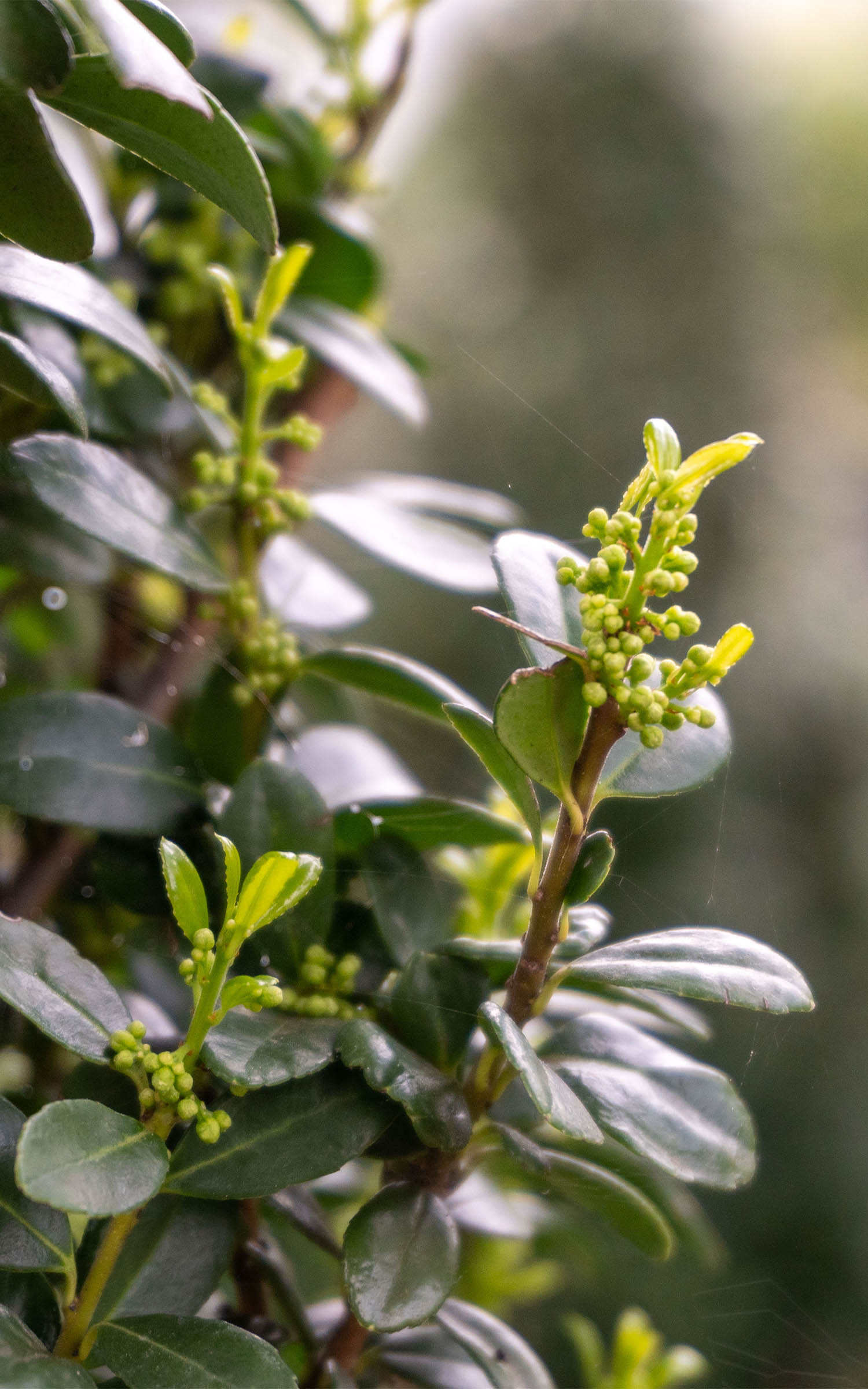
Ilex crenata
Ilex crenata
Evergreen shrub or small tree, also known as ‘Japanese holly’. It has a dense growth habit, with small glossy foliage which resembles that of Buxus. Slow growing, meaning it’s easy to clip into shape, making it perfect for topiary, or to form a neat hedge. Produces small white flowers in summer, followed by black fruits. Whilst it may be susceptible to a few pests, such as aphids and scale insects, as well as holly blight and honey fungus, it is said to be much more resilient to more serious threats, making it a reliable choice.
Euonymus japonicus ‘Jean Hugues’
A dense upward evergreen shrub, with ovate glossy foliage. Produces pale insignificant flowers in spring, with occasional fruit in autumn. A low maintenance plant, making it great for most applications, including coastal planting. Its salt tolerance makes it perfect for coastal hedge planting. Can survive most UK winter conditions, and is resistant to serious pests or diseases.

Euonymus japonicus ‘Jean Hugues’
Euonymus japonicus ‘Green Spire’
A bushy evergreen shrub native to Japan, which grows upright to about 1m max, with dark green, dense foliage. Doesn’t produce flowers or berries, but is a perfect option for hedging, and grows well in most locations. Susceptible to pests such as vine weevil and Euonymus scale, as well as powdery mildews and honey fungus, but these are not thought to be serious threats, and can be managed quite easily.
Ilex aquifolium
Known colloquially as ‘common holly’, this evergreen species features very strong, spiny, green foliage with spiked edges. Produces small white flowers in spring and summer, followed by its iconic bright red berries throughout autumn and winter on pollinated female varieties. Growth is slow, but can ultimately reach 10m in height. Extremely sturdy, and native to UK, tolerating most, if not all, UK climate conditions.
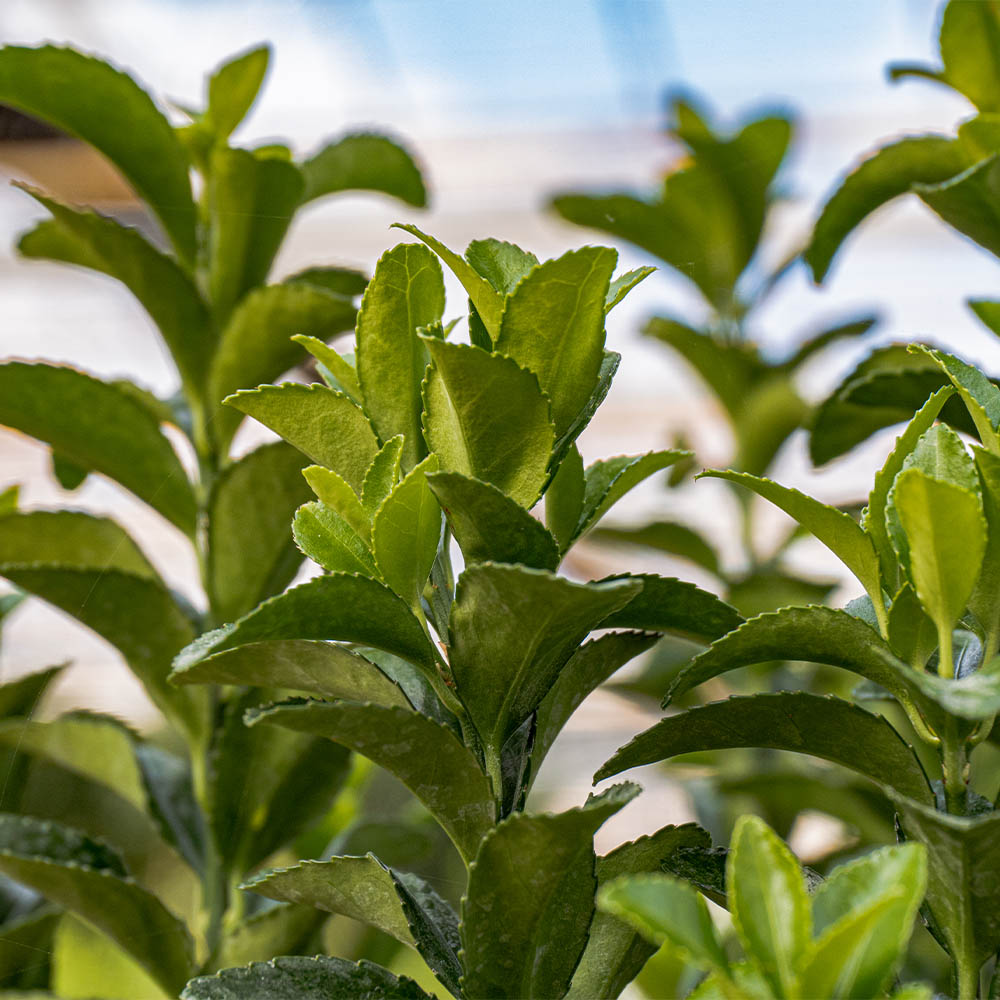
Euonymus japonicus ‘Green Spire’

Ilex aquifolium
Oak processionary moth
Oak processionary moth is a pest originating from Southern Europe, and was first discovered in the UK in 2005. It has since established in London and the surrounding area. The moth builds nests within the English oak tree (Quercus robur), and the young caterpillars feed off the bark of the tree. Whilst it is not a direct threat to the tree itself, causing little to no harm, it does however pose a health risk to humans. The caterpillars of the oak processionary moth have small venomous hairs, which cause serious irritations to human skin, and in some serious cases, if ingested, can lead to asthma. The caterpillars are specialist herbivores, meaning that they only feed on the leaves and the bark of oak trees. Occasionally however, they can be spotted on other native trees, but this is usually only when there isn’t a native English oak tree nearby.
The outbreak of oak processionary moth (OPM) has led to DEFRA (Department for Environment, Food and Rural Affairs) restricting the importation of many species of oak, particularly from OPM affected countries. As a result, sourcing oak trees from European growers has become a difficult task, often requiring alternative solutions to meet the demands of fast-paced projects. Fortunately, there are many large growing UK native trees which can serve a similar purpose to oaks, without the threat of spreading this dangerous pest. These are a few of our picks:

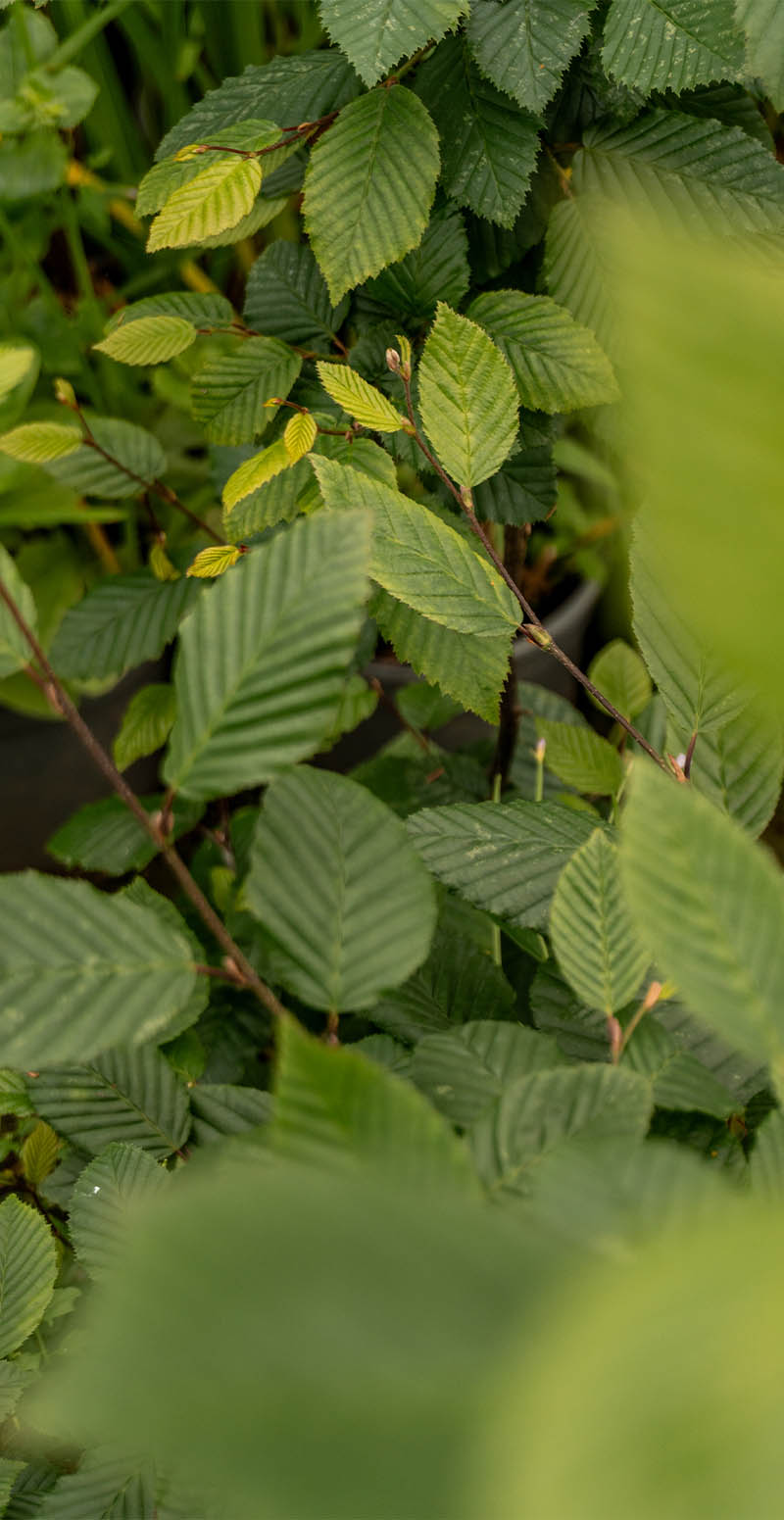
Carpinus betulus
Carpinus betulus
Also known as ‘common hornbeam’, Carpinus betulus is a large growing, UK native deciduous tree, which develops a fluted grey trunk. In spring, green catkins open, followed by fruiting catkins which can grow up to 8 cm, leaves turn to a golden yellow colour in autumn, producing a striking visual effect. The tree is extremely hardy, and will grow well in most conditions, resisting all but a few minor pests and diseases. Due to its tall and wide growth habit, Carpinus betulus serves as an ideal alternative to oak.
Tilia × europaea
Colloquially known as ‘common lime’, Tilia × europaea is a large, deciduous UK native tree which can grow up to 30m in height. It produces a broad crown at maximum height, making it well suited to replacing English oak in projects. In winter, the young shoots of branches appear bronze, with green and white flowers in summer, and yellow leaves in autumn. Although it may be susceptible to minor pests and diseases, such as aphids, horse chestnut scale, and honey fungus, generally speaking, this tree is resistant to most serious threats.

Tilia × europaea

Hebe black spot
Hebe black spot, also known as septoria leaf spot, is a fungal disease that affects the leaves of Hebe plants. It is caused by the fungus Septoria exotica, which creates small, dark brown or purple spots on the leaves. These spots can merge and enlarge, often leading to premature leaf fall and reduced plant vigour. The disease is most noticeable from late spring onwards and can cause significant aesthetic damage to the plant. Hebe varieties are a staple in landscaping projects all over the UK, being a reliable choice for dense, evergreen shrubs and in some cases as an informal hedge. Several species are commonly affected by the disease however. These include Hebe albicans, Hebe pinguifolia, Hebe rakaiensis, and Hebe ‘Red Edge’. The disease can be managed with careful supervision and regular checking, being sure to cut any infected stems to avoid spreading, but this makes the plant higher maintenance, which is less ideal when being planted in private gardens, or in areas without an ongoing regular maintenance program. Thankfully, there are many species of Hebe which have been bred specifically to be more resistant to this disease. Here are a few Greenwood recommendations:
Hebe ‘Great Orme’
A compact, rounded evergreen shrub which can grow to just over a metre. It features long, narrow, dark green leaves, and produces dense spikes of small, bright pink flowers, which eventually fade to white, throughout summer and autumn. A relatively resilient variety, it can grow well in most conditions, including in coastal plantings. Resistant to black spot, and only affected by minor threats, such as aphids and the occasional honey fungus.
Hebe ‘Wiri Charm’
A compact, dense growing evergreen shrub, with glossy, dark green foliage. Features prominent red stems for additional interest, with dark pink flowers appearing for most of the summer. It is considered to be drought tolerant, and responds well to container growing, in addition to growing in the ground. It is resistant to black spot, and may only be susceptible to a few select minor pests and diseases.
Hebe ‘Wiri Mist’
An extremely reliable, low maintenance evergreen shrub, with a compact growth habit and dense foliage, consisting of small, mid green leaves. Blooms with abundant white flowers throughout summer, providing a bright contrast to a planting scheme. Grows well in most conditions, and is tolerant of drought, making it a perfect, flexible option for most scenarios. Resists most pest and disease threats which affect Hebe plants.
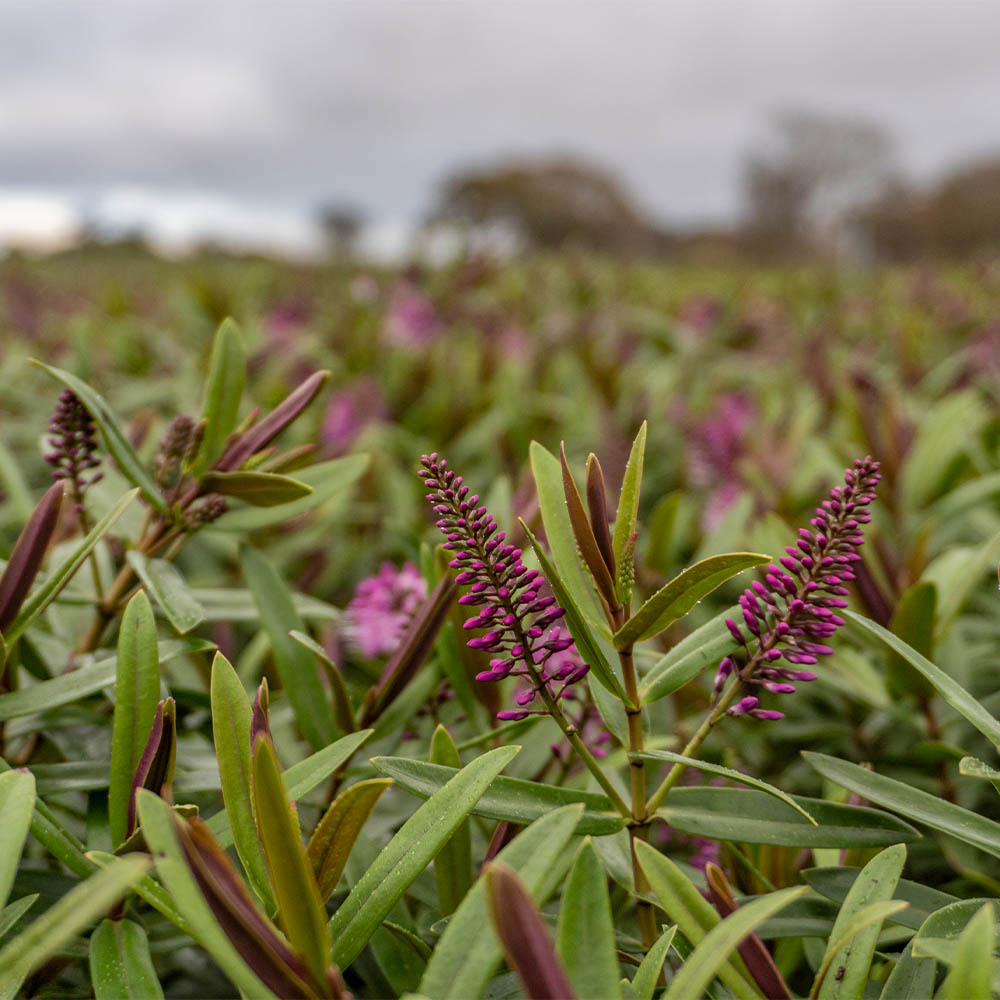
Hebe ‘Great Orme’

Hebe ‘Wiri Charm’
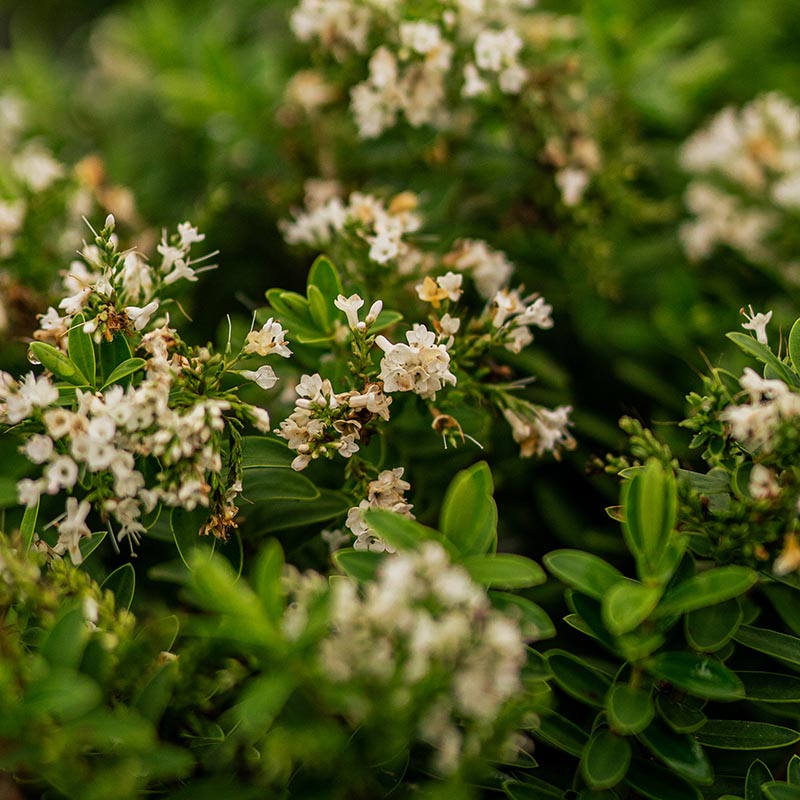
Hebe ‘Wiri Mist’
Ash dieback
Hymenoscyphus fraxineus, or ash dieback as it is commonly known, is a serious fungal disease spreading across Europe, which is expected to wipe out almost 80% of all ash species in the UK alone. In the UK, the most commonly affected species are Fraxinus excelsior (common ash) and Fraxinus angustifolia (narrow leaved ash). The disease spreads through fungal spores, which can be blown by the wind up to 30km in any direction, potentially infecting any tree within the zone of spread. It lands on and infiltrates the tree through the leaves, eventually growing inside the water systems, blocking the tree’s access to water, eventually leading to its death. The disease, believed to have originated in Asia, was first diagnosed in 1992 in Poland, and first recorded in the UK in 2012. The disease presents itself on the tree in a number of ways, including black spots on the leaves, discolouring of the tree beneath the bark, and necrotic spots on the stems. The disease can take a season to fully kill the tree, but the damage will become evident quickly, as the new shoots and leaves begin to dieback, before the crown of the tree eventually dies. This poses a major risk to the UK’s ecosystem, as according to the National Forestry Inventory for Great Britain, ash species make up 11% of all broadleaf trees in the UK, and 5% of all trees in total. Such a loss of habitat would be disastrous for native wildlife.
Fortunately, there are a number of alternatives to species affected by ash dieback, which have proven to be resilient to the more serious effects of the disease.
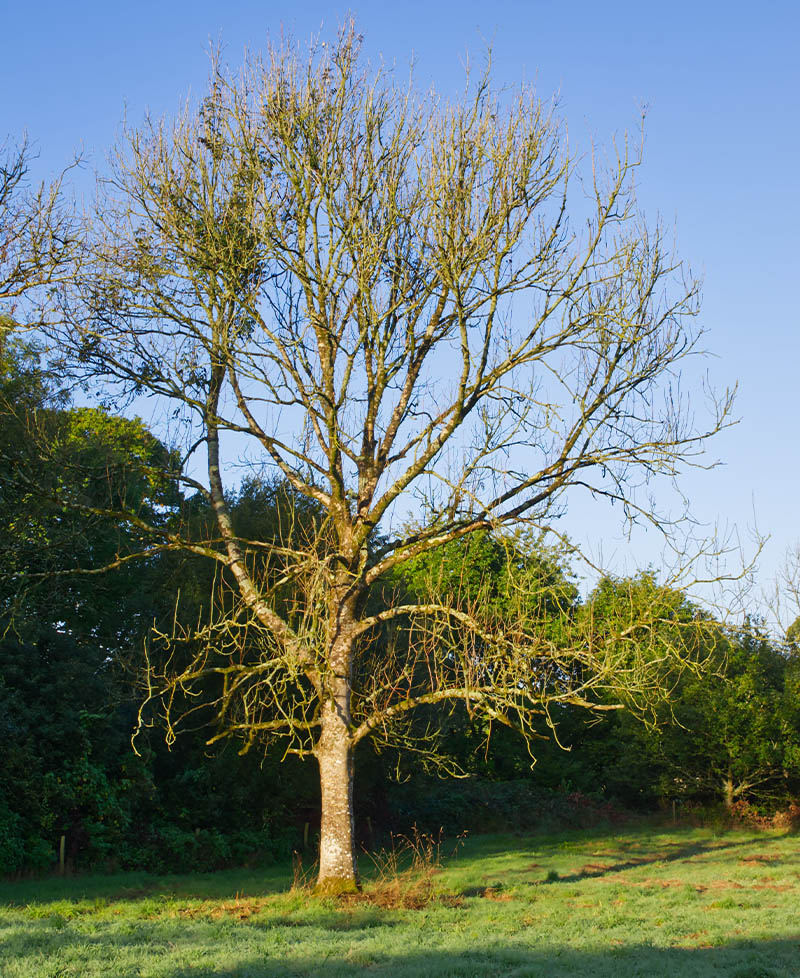

Sorbus aucuparia
Sorbus aucuparia (Mountain Ash)
Despite having ‘ash’ in its common name, this tree is of a completely different genus to common ash. Sorbus aucuparia is not only native to the UK, but also resistant to the effects of ash dieback. Also known as ‘Rowan’, it is a tall, broadly conical deciduous tree, with pinnate leaves which turn red in autumn. It produces white flowers in spring, followed by orange berries in autumn. Despite minor pests and fungi, generally speaking, Sorbus aucuparia resists more major risks to its health.
Acer pseudoplatanus (Sycamore)
Highly rated by ecologists for its ability to replace the function of ash trees for insects, moss and lichen, Acer pseudoplatanus is a British native deciduous tree, with broad, multiple lobed leaves, being up to 20cm in length. It’s fast growing, exceeding 12m in height, and wider than 8m. It produces yellow-green ‘catkin’ like flowers in spring, followed by berries in autumn. Resilient to all but a few minor pests and diseases.
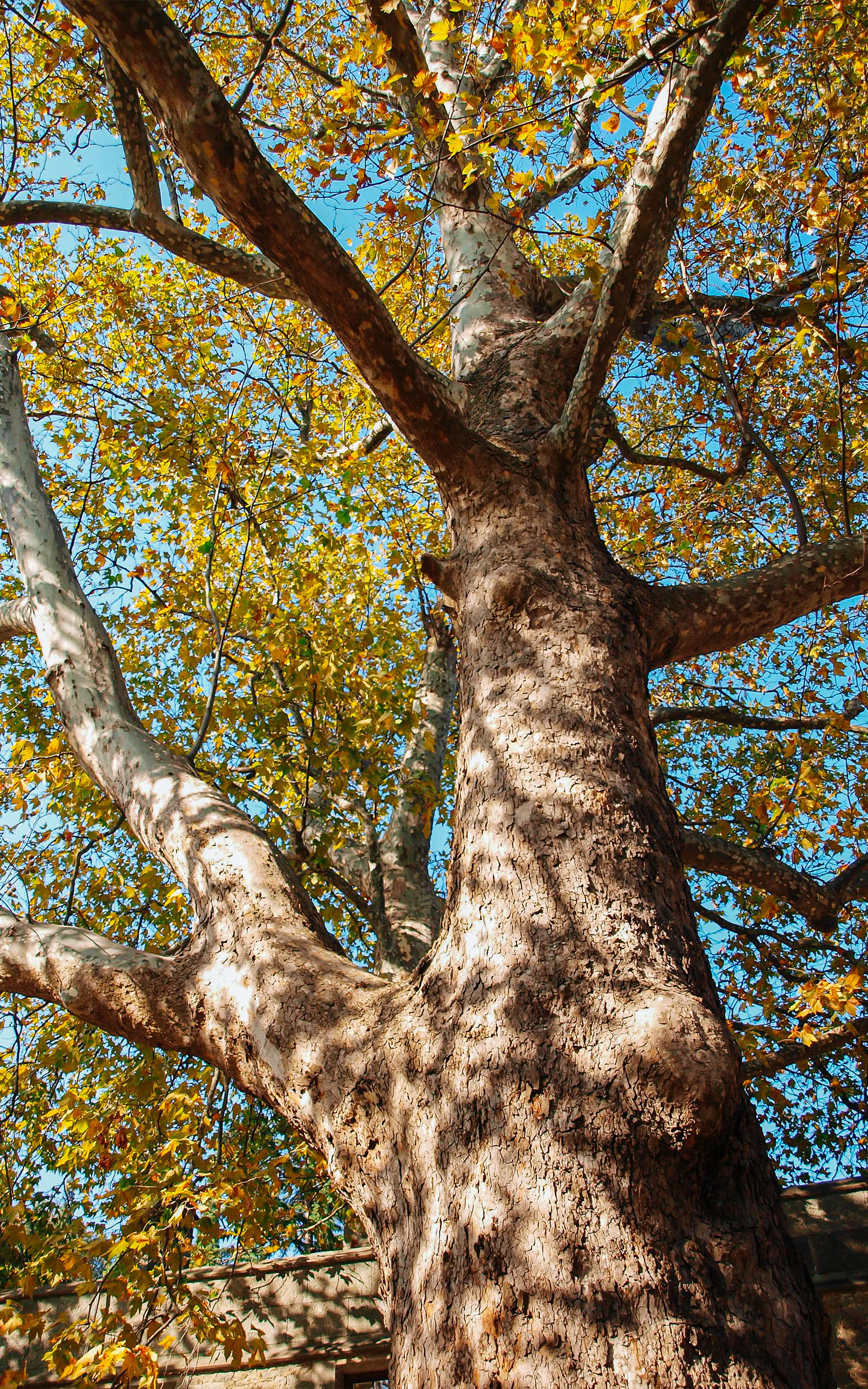
Acer pseudoplatanus
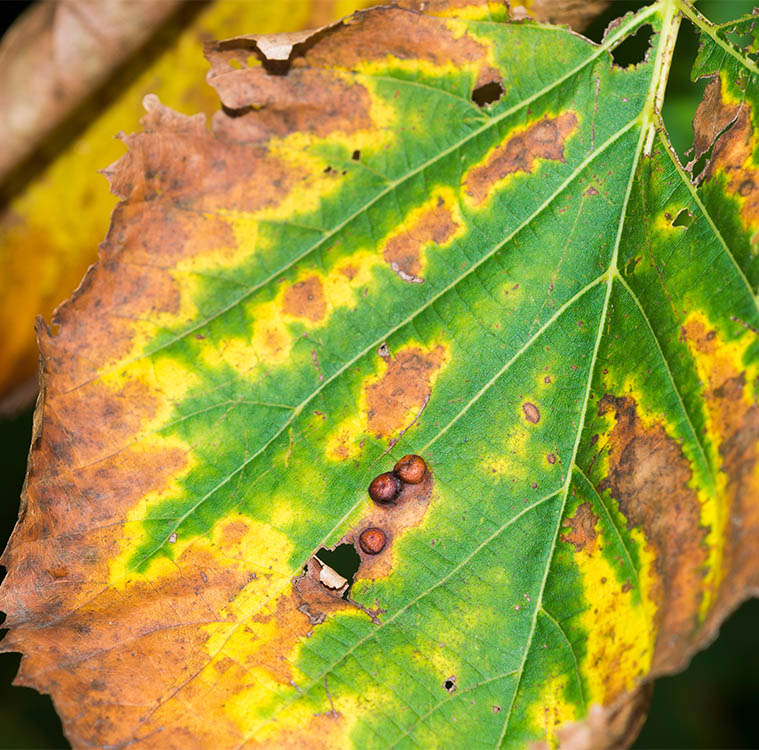
Xylella fastidiosa
Xylella fastidiosa is a bacterial disease that arrived into the country via coffee plants imported from Costa Rica. It spreads via leaf hopping insects, which inject the bacteria whilst feeding. The bacteria cells block the water vessels of the leaves, causing total failure of the plant. Not only is it difficult to spot, but there is currently no known cure or treatments for the bacteria. Over 320 different genera of plants are known to be vulnerable to attacks, with varying levels of risk associated. Amongst the highest risk of plants are Lavandula, Rosmarinus officinalis, Olea europaea and Prunus dulcis. It is currently spreading across areas of Spain, Portugal, Southern France, and Italy. Whilst it is not considered to be an outbreak in the UK, there are extremely strict measures in place to prevent its spread. Once it is identified, a large quarantine area must be set up, 5km in diameter from the infected site, in order to prevent the further spread of the disease.
Whilst it is not yet suggested to limit the planting of vulnerable species, care must be taken when importing plants from regions where Xylella has been reported. In particular, olive trees (olea europaea) are subject to rigorous checks, and must be issued with individual plant passports before being exported from Xylella-affected countries.
The importance of being vigilant
The best way to protect our native species from invasive foreign threats is to maintain strict and rigorous biosecurity standards. Even a minor contamination can have serious effects on our ecosystems. There are many examples of outbreaks of pests in the UK from seemingly innocuous sources, which have led to widespread habitat loss. Currently, UK football pitches are facing an outbreak of Meloidogyne fallax, also known as ‘Root Knot Nematodes’. It’s a microscopic worm that attacks the roots of many of our food crops, such as carrots and potatoes, and its origin in the UK has been traced back to a single turf machine, which was loaned to Brazil for the 2014 world cup, and returned without being cleaned. The nematodes were transported on the machine, and subsequently made their way into the British Ecosystem via the machine’s use on local football pitches, and transported to different sites on the boots of players. It is an example of such a seemingly small oversight leading to potentially larger consequences. Alternatively, pests and diseases can travel to the UK in other ways, such as burrowed into the wood which is used to make imported furniture, or even in the wood used for shipping pallets. Vigilance is of the upmost importance to all who handle imported plants in the UK, to ensure that we protect our green spaces from potential ecological devastation.
Greenwood is proud to be Plant Healthy certified, through the national scheme which assesses and accredits horticultural businesses based on their ability to uphold strict biosecurity measure. The nursery and transport team have all been trained to operate to these guidelines, being alert to any potential threats on imported plants, and implement strict procedures with regards to handling and checking all plants and trees. Greenwood recognises the importance of protecting native species from the threat of invasive posts and diseases, and ensures that every plant sold has undergone sufficient inspection to ensure they are disease and pest free.
For more information about our biosecurity procedures, read our policy here.

